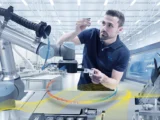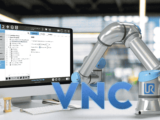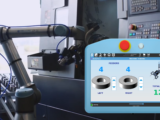Robpod Studio and RoboDK, a perfect match!
Robot Simulation Environments
In the realm of industrial robotics, innovation often hinges on the ability to efficiently prototype, test, and deploy applications. Here, simulation environments emerge as indispensable tools, offering a virtualized platform to build and refine robotics work cells before physical implementation. These environments not only accelerate development but also aid in scenario forecasting and optimization, enabling informed decisions regarding implementation alternatives.
Robot simulators are also very useful tools for robot programmers and developers because they provide a cost-effective offline programming approach. Without being physically on-site, programmers can develop a robot program from their office or home using a simulator environment. Only when they have a working, almost done robot program inside the simulator environment, they can go on-site to deploy the solution on real robots.

Not all Robot Simulators are the same
Not all simulators are the same, there are many different types of robotics simulators out there, but the two main types are:
- Physics Engine Simulators: These simulators solve differential equations to reproduce an extremely realistic physics world by applying dynamic laws such as gravity, force interactions, and collisions. These tools are particularly suited for research and educational purposes. They provide a realistic virtual environment where robots can interact with objects and obstacles just as they would in the physical world. This realism enables researchers to test algorithms, control strategies, and manipulator designs under lifelike conditions. Widely used Physics Engine Simulators include Gazebo and CoppeliaSim.
- Discrete Event Simulators: These simulators often do not provide a precise modeling of physics laws because they operate based on events rather than continuous time. They are particularly useful for systems where changes occur at specific moments. In robotics, events such as sensor readings, control commands, or task completions can be simulated accurately, providing insights into system behavior. Discrete Event Simulators are commonly used by robotics programmers and professionals because they offer an offline programming approach that enables the deployment of real industrial applications. RoboDK is a great simulator platform for industrial robots programming.
Off-Line Programming
Offline programming (OLP) is a method used in robotics for programming robots without the need for direct interaction with the physical robot or its control system. Instead, it involves creating, editing, and testing robot programs in a virtual environment, typically on a computer or workstation, separate from the robot’s actual workspace.
RoboDK
RoboDK is a powerful simulation and offline programming software for industrial robots. It provides a comprehensive platform for robot programming, simulation, and optimization, allowing users to create, visualize, and test robotic applications in a virtual environment before deploying them to the physical robot.

RoboDK’s architecture works in this way: users can program and design a robotics cell using general commands such as MoveJ and MoveL provided inside the simulator. Then, RoboDK, using a specific post-processor for each robot brand, is able to automatically create a real robot program composed of specific commands for the chosen target robot. In this way, users can nearly ignore how a certain robot is programmed and can refer only to the general commands provided inside the simulator. It will be RoboDK’s job to convert the simulated program to a working program with specific instructions for the real robots.

Robpod And RoboDK: a perfect combo!
At Robpod, we love RoboDK! Our development platform, Robpod Studio, is deeply integrated with RoboDK simulator to offer Universal Robots programmers an even more advanced experience. With Robpod Studio, you can program a cobot using its native script language and then execute the same code both inside the simulation environment and on real robots. This way, what you code is what you simulate, and what you simulate is exactly what you execute in the real world.

Robpod Studio integration has two key benefits:
- Code-First Approach: Programmers can take advantage of the specific robot programming language and instructions, making it possible to deliver applications that exploit the capabilities of each robot.
- Easy Script Changes: There is no need for a manual post-processor conversion to convert a simulation into a working robot script each time the simulation changes. RoboDK Studio can directly simulate the robot script inside the RoboDK simulator, making it really fast to test script changes.
Robpod Studio makes the most of RoboDK’s capabilities even during the off-line programming phase. When a simulator is connected, Robpod Studio live auto-completion suggestions include positions of simulated robots. This makes it very fast for a robot programmer to compose a Universal Robots script using data coming from the simulator.
Download now Robpod Studio and RoboDK to unleash the full potential of your robotics projects!




